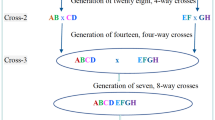Abstract
A total of 1915 Kabuli chickpea lines were screened in a wilt sick plot containing Fusarium oxysporum f.sp. ciceri race 0 at Béja, Tunisia. Complete resistance was found in 110 lines and this result was confirmed by a laboratory screening method. Principal components analysis showed that > 80% of the variation of the resistant lines was explained by hundred seed weight and days to maturity. Cluster analysis divided the resistant lines into four groups: 21 had high seed weight (48.25 ± 3.81 g) and early maturity (95.09 ± 2.50 d), 24 had high seed weight (46.84 ± 2.10 g) and late maturity (117.00 d), 34 had low seed weight (22.35 ± 4.72 g) and early maturity (92.97 ± 3.97 d) and 31 had low seed weight (19.62 ± 5.37 g) and late maturity (112.09 ± 4.51 d).
Similar content being viewed by others
References
Anonymous, 1985. Chickpea descriptors. IBPGR Secretariat, Rome, Italy.
Bhatti, M.A., & J.M. Kraft, 1992. Reaction of selected chickpea lines to Fusarium and Thielaviopsis root rots. Plant Dis 76: 54–56.
Cubero, J.I. & M.T. Moreno Cubero, 1990. Recent advances in chick-pea improvement and prospects for the nineties: the Mediterranean region of Europe. In: Chickpea in the Nineties: Proceedings of the Second International Workshop on Chickpea Improvement, 4–8 December, pp. 263–264. ICRISAT, Patancheru, India.
Gregory, P.J., 1988. Root growth of chickpea, faba bean, lentil, and pea and effects of water and salt stresses. In: R.J. Summerfield (Ed.), World Crops: Cool Season Food Legumes. Current Plant Science and Biotechnology in Agriculture, pp. 857–867. Kluwer Academic Publishers.
Halila, M.H., H. Gridley & P. Houdiard, 1984. Sources of resistance to Fusarium wilt in kabuli chickpeas. Int. Chickpea Newslett 10: 13–14.
Halila, H.M. & M. Harrabi, 1990. Breeding for dual resistance to Ascochyta and wilt diseases in chickpea. In: M.C. Saxena, J.I. Cubero & J. Wery (Eds.), Options Mediterranennes, Serie A: Seminaires Mediterraneens No 9. Proceedings of the International Workshop on Present Status and Future Prospects of Chickpea Crop Production and Improvement in the Mediterraen Countries, ECC/CIHEAM/ICARDA, 11–13 July 1988, pp. 163–166. Zaragoza, Spain.
Halila, M.H. & R.N. Strange, 1996. Identification of the causal agent of wilt of chickpea in Tunisia as Fusarium oxysporum f.sp. ciceri race 0. Phyto Pathol 35: 67–74.
Haware, M.P., Y.L. Nene, R.P.S. Pundir & J. Narayana Rao, 1992. Screening of world chickpea germplasm for resistance to Fusarium wilt. Field Crops Sci 30: 147–154.
Huisman, O.C., 1982. Interrelations of root growth dynamics to epidemiology of root-invading fungi. Ann Rev Phytopathol 20: 303–327.
Jain, K.C., B.P. Pandya & K. Pande, 1981. Genetic divergence in chickpea. Indian J Genet 41: 220–225.
Jiménez-Diaz, R.M., K.B. Singh, A. Trapero-Casas & J.L. Trapero-Casas, 1991. Resistance in kabuli chickpeas to Fusarium wilt. Plant Dis 75: 914–918.
Khan, I.A., M. Bashir & B.A. Malik, 1989. Character association and their implication in chickpea breeding. Pak J Agr Sci 26: 214–220.
Latin, R.X. & S.J. Snell, 1986. Comparison of methods for inoculation of muskmelon with Fusarium oxysporum f.sp. melonis. Plant Dis 70: 297–300.
Nene, Y.L. & M.P. Haware, 1980. Screening chickpea for resistance to wilt. Plant Dis 64: 379–380.
Nene, Y.L., M.P. Haware & M.V. Reddy, 1981. Chickpea diseases: resistance screening techniques. ICRISAT Information Bull 10 10 pp.
Nene, Y.L., M.P. Haware, M.V. Reddy, J.C. Phillips, E.L. Castro, S.R. Kotasthane, O. Gupta, G. Singh, P. Shukla & R.P. Sah, 1989. Identification of broad-based and stable resistance to wilt and root rots in chickpea. Indian Phytopath 42(2): 499–505.
Papavizas, C.C., 1967. Evaluation of various media and antimicrobial agents for isolation of Fusarium in field soil. Phytopathology 57: 848–852.
Pundir, R.P.S., K.N. Reddy & M.H. Mengesha, 1988. ICRISAT chickpea germplasm catalog: Evaluation and analysis. Patancheru, A.P. 502 324, India.
Singh, D.N., A.K. Kush & L. Singh, 1980. Genetic variation in root growth and nodulation in chickpea. Int Chickpea Newslett 3: 16–18.
Singh, H., J. Kumar, M.P. Haware & J.B. Smithson, 1987a. Genetics of resistance to Fusarium wilt in chickpea. In: P.R. Day & G.J. Jelliss (Eds.), Genetics and Plant Pathogenesis, pp. 339–314. Blackwell Scientific Publication, Oxford, UK.
Singh, H., J. Kumar, J.B. Smithson & M.P. Haware, 1987b. Complementation between genes for resistance to race 1 of Fusarium oxysporum f.sp. ciceri in chickpea. Plant Pathol 36: 539–543.
Singh, K.B., G. Bejiga & R.S. Malhotra, 1990. Associations of some characters with seed yield in chickpea collections. Euphytica 49: 83–88.
Singh, K.B. & M.V. Reddy, 1991. Advances in disease-resistance breeding in chickpea. Adv Agronomy 45: 191–222.
Singh, K.B., L. Holly & G. Bejiga, 1991. A catalog of kabuli chickpea germplasm. ICARDA. Aleppo, Syria. 398 pp.
Sutherland, M.L. & G.F. Pegg, 1992. The basis of host recognition in Fusarium oxysporum f.sp. lycopersici. Physiol Mol Plant Pathol 40: 423–436.
STAT-ITCF, 1988. Institut Technique des Céréales et des Fourrages. Logiciel d'analyses statistiques. 4 Version ITCF, 91720 Boigneville, France.
Upadhyaya, H.D., J.B. Smithson, M.P. Haware & J. Kumar, 1983a. Resistance to wilt in chickpea. I. Inheritance of late wilting in response to race 1. Euphytica 32: 447–452.
Upadhyaya, H.D., J.B. Smithson, M.P. Haware & J. Kumar, 1983b. Resistance to wilt in chickpea. II. Further evidence for two genes for resistance to race 1. Euphytica 32: 749–755.
Van der Maesen, L.J., 1972. Cicer L., a monograph of the genus, with special reference to the chickpea (Cicer arietinum L.), its ecology and cultivation. Medelingen Landbouwhogeschool Wageningen 72–10 (1972). Wageningen, Netherlands: H. Veenman and Zonen, N.V. 342 pp.
Zink, F.W., 1992. Genetics of resistance to Fusarium oxysporum f.sp. melonis races 0 and 2 in muskmelon cultivars honey dew, iroquois and delicious 51. Plant Dis 76: 162–166.
Author information
Authors and Affiliations
Rights and permissions
About this article
Cite this article
Halila, M., Strange, R. Screening of Kabuli chickpea germplasm for resistance to Fusarium wilt. Euphytica 96, 273–279 (1997). https://doi.org/10.1023/A:1003051100683
Issue Date:
DOI: https://doi.org/10.1023/A:1003051100683




